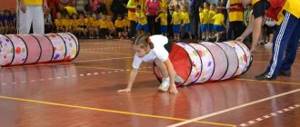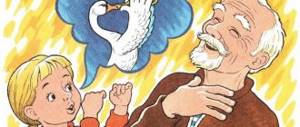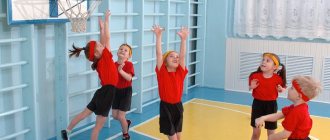MILITARY SPORTS RELAY RACE
The complexity of the stages of this relay race is determined by the age of the participants. The equipment and props are simple. This relay race can be carried out both on the ground and in the gym.
MARCH CHARGE
At the starting line - a duffel bag with a load (weight - depending on the age of the participants). On command, each participant puts on a duffel bag, runs to the turning point and back, and passes the bag to the next participant. The team whose last participant returns to the starting line first wins.
TRANSPORTATION OF THE WOUNDED
The team is divided into threes. In each trio, two people make a “chair” from intertwined hands and on this “chair” they carry the third to the turning point and back.
OBSTACLE COURSE
The simplest obstacle course is ropes stretched between trees at different heights, over which you need to jump. In the hall, benches can serve as obstacles. Obstacles can be overcome both on the way to the turning point and on the way back (or you can make the way back around the obstacles).
STORMING THE HEIGHTS
Climbing a fairly steep slope using a rope tied to a tree. The team that reaches the top with its entire team first wins. In the gym, the “slope” is made of benches attached to the wall bars, and the descent is carried out along the crossbars. Each participant in this stage begins to move after the previous participant returns to the starting position.
SNIPERS
Shooting for accuracy in hitting the target with tennis balls, pine or spruce cones.
GRENADE THROWING
Throwing any suitable objects at a distance - balls, wooden “grenades”, cones, etc.
QUIZ FOR CONTENTS OF RUSSIAN MILITARY HISTORY
1. This man was born in Denmark, but in his youth he entered the Russian fleet, and Russia became his second homeland. He fought under the Russian flag against the Swedes and took part in difficult sea campaigns. An island, a strait and part of the ocean are named after him. What was his name?
2. A monument was erected to this literary hero - a soldier of the Great Patriotic War - in the homeland of his author, in the ancient Russian city of Smolensk. “About fire, about snow, about tanks, about a dugout and foot wraps... about shag and frost” is discussed in the book about a fighter. Name the author and his hero.
3. This Moscow prince is used to fighting. He was first taken on a military campaign as a boy. But his main battle took place when the prince was thirty years old. “Dear brothers and friends,” he said at the military council. - Know that I came here to save the Russian land from captivity and ruin. Today we will go beyond the Don and there we will either win or lay down our heads.” State the name and nickname of the prince.
4. This commander had to make many difficult decisions. For example, surrender Moscow to the enemy without a fight. But everyone knows his words: “Russia is not lost with the loss of Moscow.” Name the commander.
5. A monument to these people stands in the very center of Moscow - on Red Square. They accomplished their feat in 1612. Say their names.
6. This sailor had the opportunity to command Russian forces in the last major battle of the sailing fleet. This battle took place in Sinop Bay. Say the sailor's name.
7. “Russia is great, but there is nowhere to retreat. Moscow is behind us." Whose words are these and to whom were they spoken?
8. On his seal, this military leader and statesman carved the words: “I am a student and need teachers.” And now the city he founded bears his name. What was the name of this “student”?
9. Which commander instilled in his soldiers that “death flees from the bullet and bayonet of the brave”, that “it’s hard to learn, but it’s easy to march”?
10. Which commander did the people award the even title of “Marshal of Victory”?
- Victory Day - May 9th
- Day of Slavic Literature and Culture - May 24th







